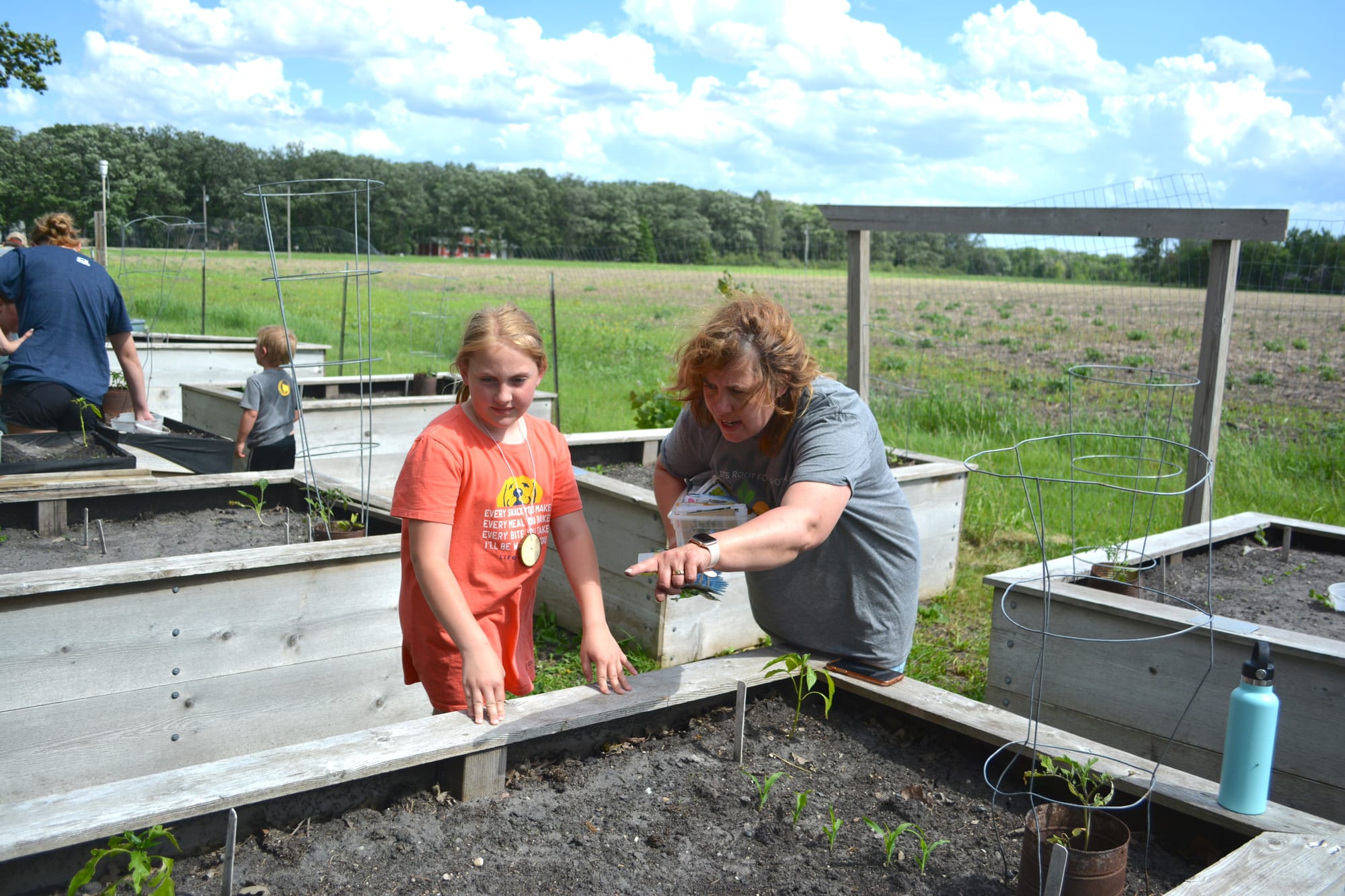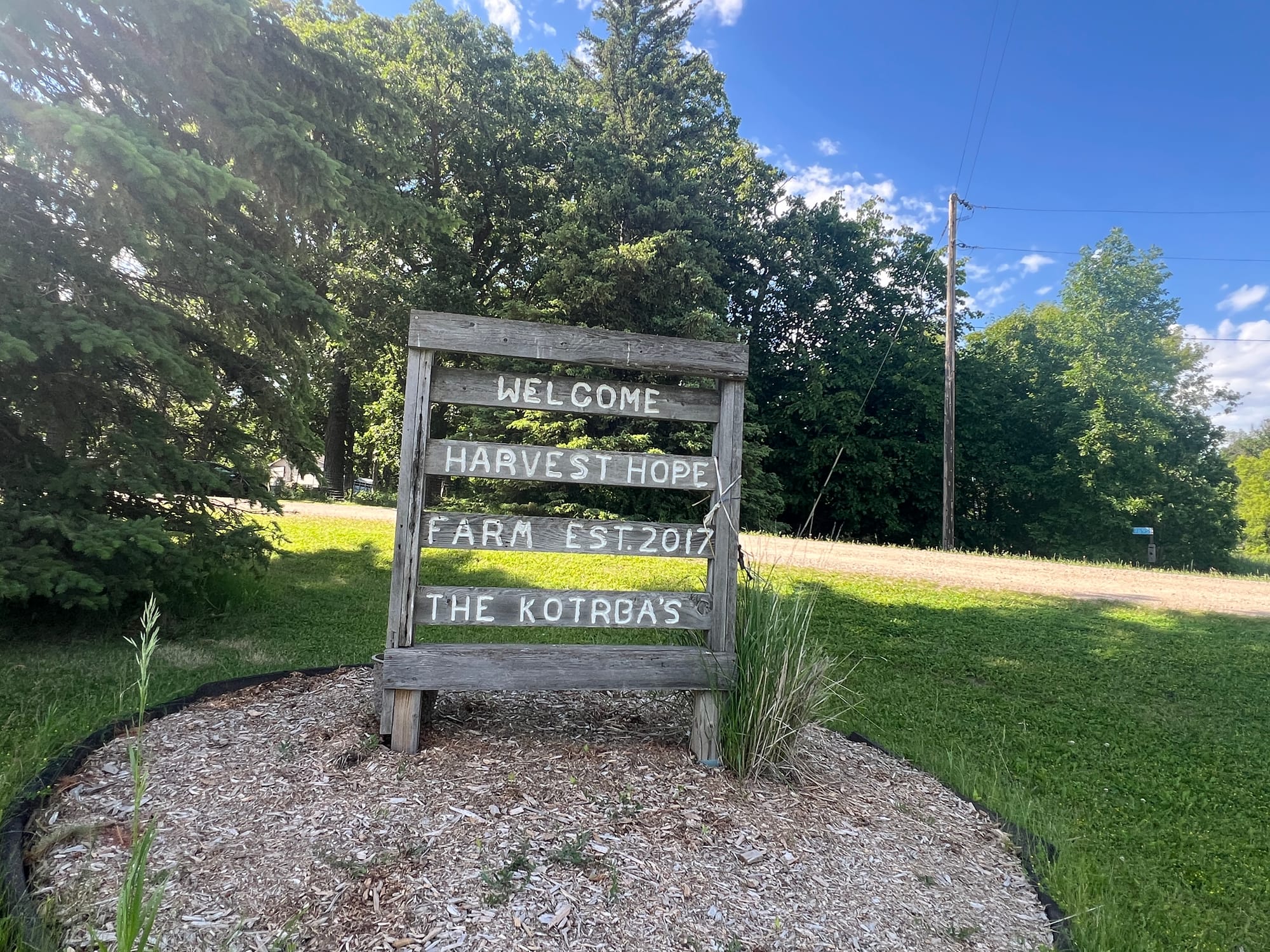Kids flex green thumbs at Moorhead farm camp
Harvest Hope Farm has a waitlist for its summer camps; experts say repeated exposure to nature benefits kids if organizers can break down barriers like cost.

MOORHEAD, Minn. – Twelve children weeded raised garden beds and watered seedlings they planted at Harvest Hope Farm on a sunny June day.
They waited patiently for watering cans, filled them up at a nearby hose, and watered the green shoots sticking out of the dirt.
Work in the garden was one stop in a two-hour session at Harvesting Hope for Others Farm Camp, which the nonprofit organization hosts weekly from the end of May to the middle of August.
Lynn Kotrba, founder and executive director of Harvest Hope Farm, and her husband, Jason, founder and board president, started the camps to share the benefits of farm life with the community. Jason is a principal, and Lynn worked in foster care until she started running the farm full-time three years ago.
“We just wanted to find a way to work with kids outside of our profession, and we saw for our own kids how good being on the farm was and how good being out in nature was for them,” Lynn said. “We just wanted to be able to impact other kids and families that way as well.”

The nonprofit hosts several types of farm camp. Harvesting Hope for Others allows children from 6-13 years old to grow food from planting to harvest in their own 4-foot by 6-foot raised garden bed. The produce is donated to families in need in Fargo/Moorhead.
There’s also Llama Llama Camp for children ages 3-5 based on the books written by Anna Dewdney, a Catholic Bible camp, day camps, and the organization has a mobile farm camp the Kotrbas take to schools.
“We're really trying to teach kids about sustainable food resources, where their food comes from, and how to be good stewards to the environment,” Lynn said. “And then through that there's just other impacts. … Just digging in the dirt can cause an increase in serotonin in the brain which then improves mood.”
Devices, such as smartphones and tablets, are prohibited at farm camp. And in moving from one area of the farm to the next, time flies.
On June 12, the children watched Jason feed food scraps to the pigs and learned why pigs like mud. (Pigs can’t sweat, so mud cools them off.) They got to see and hold lambs, before throwing food scraps to the egg-laying chickens.

Then they checked on the meat chicks. Jason weighed a chick and had the children calculate how much weight the small chicken gained compared to the previous week. They fed the chicks before moving on to check their garden beds.
After their gardens, the children visited the biodome and learned more about it from Bob Pieri, a professor of mechanical engineering at North Dakota State University.
Lastly, they gathered under the shade of some trees to eat popsicles and complete an art activity.

What happens when kids connect with nature?
Outdoor learning experiences, similar to the camps Harvest Hope Farm hosts, offer children many benefits, said Dr. Cathy Jordan, a professor of pediatrics at the University of Minnesota and research director for the Children and Nature Network.

Children tend to be:
- Healthier. Consistent time spent outdoors gives children more opportunities for physical activity, and it allows them to get their hands dirty, which has been shown to improve the gut microbiome, Jordan said.
- Happier. Nature helps boost mood; decrease negative thoughts, stress, and anxiety; and increases social connection, she said.
- Smarter. “Nature helps us build a better brain,” Jordan said. Research has shown that children who grow up in nature have larger volumes in the areas of the brain responsible for attention, learning, and memory.
- More successful in school. Children who attend nature-based learning programs, for example, tend to have better academic performance, as measured by grades, graduation rates, and test scores, she said. Nature-based learning is “engaging, it's inquiry based, it's hands-on, it's collaborative, it is active, and social,” Jordan said. “Those are all high impact pedagogical practices.”
- Better stewards of the environment. When people are exposed to nature as children, they are more likely to have a connection with nature and to care about the environment, Jordan said.
Jordan pointed to research done by Ulrich Dettweiler in Germany where one group of children went outside one day per week during the school year while their peers stayed inside. Dettweiler and his team took saliva samples from the children throughout the day and used the saliva to measure their cortisol – or stress – levels. They found cortisol levels among the students who went outside gradually declined throughout the day. However, cortisol levels among the children who stayed indoors did not drop throughout the day like those of their outdoor-learning peers.
Jordan also noted that for nature to affect children, they need repeated exposure to it.
“This idea of a repeated experience allows for an amassing, I guess you could call it like a dose of nature, that could be effective in achieving some of these outcomes that I've mentioned,” Jordan said. “One-off sorts of experiences – a field trip or if the kid only went one week or had one day at farm camp or something like that – you wouldn't expect to see the kinds of outcomes that I've been talking about.”

How some lessons on the farm last
Harvest Hope Farm tests campers at the start and at the end of camp to see whether and how much they’ve grown over the course of 11 weeks.
“We see a huge improvement in knowledge as far as sustainability and what they've learned,” Lynn said.

Parents and children also see the impact.
Allison Fulton has three children who attend camp at Harvest Hope Farm.
The Fargo resident also sits on the organization's board of directors, and said she thought she knew what she was getting her kids into.
“It’s one thing to know they’re going to have a speaker from NDSU to explain pollinator gardens and how they work. And from a board member perspective that sounds good and wonderful,” Fulton said. “But then as a parent, being able to see my kids go, they learn that information, and then weeks or months later they’re still sharing that information with me and incorporating it into their lives at home, that’s the piece that I didn’t expect. … It really has stuck with them and been deeply woven into our lives at home.”

Emmeline Fillipi, 9, said it was her fourth summer at farm camp. This year, she had peppers, corn, lettuce, carrots, peas, tomatoes, and radishes in her raised garden bed.
Her favorite thing about camp is growing and picking food for families in need “because it’s helping people,” she said.

What’s next for the farm: More space to grow
Harvesting Hope for Others Farm Camp is currently limited to 34 students total. They have a wait list of children who would like to attend. Lynn said they need to acquire more land to expand, as they currently don't have the space to host more sessions.
Cost can be a barrier. Harvesting Hope for Others camp costs $220 per student. However, Lynn said the nonprofit has donors who cover scholarships for students who can’t afford the fee.

Jordan pointed to a few other limitations, including transportation to camp and child care for a camper’s siblings if a parent has to drive them.
She also said nature can have different cultural meanings for some groups of people which affects how they interact with nature. For example, people whose ancestors were enslaved or who were migrant workers may have conflicted feelings about farming compared to people whose families don’t carry similar histories.
“That’s a really important thing to remember that not all people have a positive response to all forms of nature,” Jordan said.

Since Harvest Hope Farm hosted its first camp in 2018, the organization has hosted children from all walks of life.
“We have foster kids, we have doctors' kids, we have low income, middle income, higher income. We have kids from the juvenile justice system. … We've had lots of different faiths. It's open to everyone,” Lynn said.
“A goal we don't necessarily state but one thing we want to do is just to let kids be kids again,” Lynn said, “and just help them have fun outside in nature.”
This story was edited and fact-checked by Nora Hertel.
